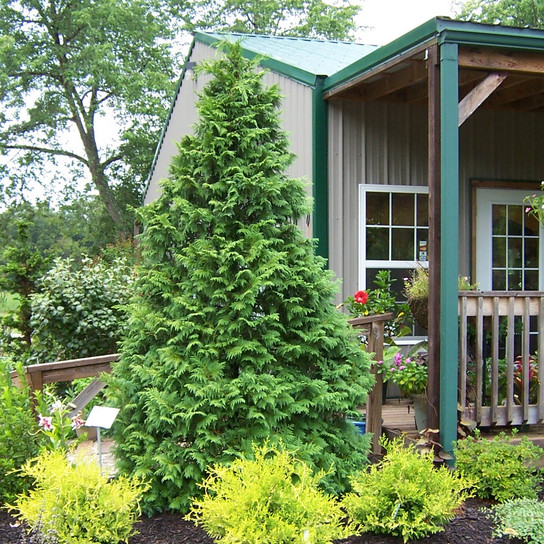
Cypress Trees
Uses:
- Specimen Plants
- Pond Borders
- Privacy Screen
- Vertical Lines to Landscaping
Features:
- Pest & Disease Resistant
- Heat, Cold, Salt, & Humidity Tolerant
- Evergreen Scale-Like Foliage
Sunlight:
- Partial Sun to Full Sun
- 5+ Hours of Direct Sun
Growing Zones:
- 2-9
- What is My Zone?
True cypress trees are members of the Cupressus genus. Most are hardy evergreens with emerald green, scale-like foliage. Leland Cypress and Italian Cypress grow quickly and make excellent privacy screens. Bald and pond cypresses, part of the related Taxodium genus, grow well near water and are deciduous. By contrast, the low-growing Russian and Siberian cypresses (Microbiota decussata) make an excellent evergreen groundcover and are useful for erosion control.
About Cypress Trees

Depends on species
North America, Asia, Europe
Trees, Shrubs
Evergreen
2 - 13
Gold/Yellow, Green, Red/Burgundy
No true flowers
Conical, Erect
Bees, Birds
Drought, Salt
Deer, Rabbits
How To Use Cypress Trees In The Garden
Many gardeners admire cypress trees for their distinctive columnar silhouettes, attractive scaly foliage, and relatively quick growth. These evergreens can reach impressive heights in suitable climates, providing year-round greenery and a subtle, resinous fragrance. Several popular varieties (like the fast-growing Leyland cypress) are valued for forming natural privacy screens or windbreaks. Cypress trees are often low-maintenance and adaptable once established.
Outside, rows of cypress along property edges can create a striking sense of enclosure and shelter. Interspersing them with low shrubs or ornamental grasses highlights the contrasting shapes while preserving an airy, layered look. Some homeowners place cypress near pathways or gardens as a unifying element for a Mediterranean or coastal design theme. In rural settings, planting cypress in clusters can yield a woodland effect, especially when mixed with other evergreens or broadleaf specimens.
Types of Cypress Trees
| Type | Scientific Name | Native Range | Foliage | Zones | Uses | Features |
|---|---|---|---|---|---|---|
| Alaska (Nootka) Cypress | Callitropsis nootkatensis | Pacific Coast of AK → northern CA | Gray- to blue-green, scale-like sprays | 4 – 8 | Specimen, stream/pond edges, cool-mountain landscapes | Exfoliating gray bark; very rot-resistant wood; highly shade & snow tolerant |
| Leyland Cypress | × Cuprocyparis leylandii (hybrid) | Garden origin (Wales, 1888) | Gray- to blue-green flattened sprays; evergreen | 6 – 10 | Hedges, screens, wind-breaks, Christmas-tree farms | Rapid growth; shears well; tolerant of varied soils; canker & root-rot prone if stressed |
| Bald Cypress | Taxodium distichum | Southeastern U.S. swamps & river valleys | Soft, feathery needles turn orange-brown in fall (deciduous conifer) | 4 – 9 | Large shade tree, rain-gardens, wet sites, timber | Tolerates flooding or dry soil; long-lived (1,000+ yrs); rot-resistant heartwood |
| Pond Cypress | Taxodium ascendens | Coastal plain ponds & black-water swamps, SE U.S. | Bright-green, awl-like needles; bronze-brown fall color (deciduous) | 5 – 9 | Wetland restoration, pond margins, vertical accent | Thick, fire-resistant bark; adapts to drier soils; wildlife habitat |
| Arizona Cypress | Hesperocyparis arizonica | SW U.S. & N. Mexico mountains | Silvery to bluish gray-green scale leaves | 7 – 9 | Specimen, windbreaks, screens, xeric gardens | Rapid 4–8′ yr growth; fragrant foliage; cones open after fire |
| Mediterranean (Italian) Cypress | Cupressus sempervirens | Eastern Mediterranean & Iran | Dark green, aromatic, scale-like leaves | 7 – 10 | Formal accents, allées, Mediterranean-style gardens, tall screens | Iconic pencil-shape; drought & lime-soil tolerant; wood fragrant & moth-repellent |
Cypress Trees Care
In terms of planting, pick a sunny spot with well-draining soil, ideally slightly acidic or neutral in pH. Regular, abundant sunlight helps maintain dense foliage, so avoid overly shaded sites if you want to preserve that full, upright form. Water regularly during the first year or two, permitting roots to take hold, then let nature handle the majority of moisture needs unless a severe drought strikes. A gentle, balanced fertilizer in early spring supports healthy growth; too much nitrogen can encourage lanky, weak branches.
Prune sparingly—usually in late winter or early spring—to refine shape or remove damaged growth, avoiding any heavy cuts into older wood. In colder regions, a layer of mulch around the base can help protect shallow roots from freezing weather, while container-grown specimens benefit from moving to a sheltered spot. Potted cypress demands a large vessel and a free-draining soil mix—overly tight quarters or waterlogged compost can stress it quickly.
Learn More About Cypress Tree Care

Cypress Companion Plants
Give these evergreens a site with full sun, sharply draining soil, and only occasional irrigation once they’re rooted in. Russian sage and aromatic lavender share the same lean, dry conditions, and their silvery leaves echo the cypress foliage while offering contrasting broad or mounded forms. For bold texture, add a trailing sweet potato vine and a sculptural euphorbia; both shrug off heat, demand little water, and set the cypress’ vertical or conical outline against striking foliage.









